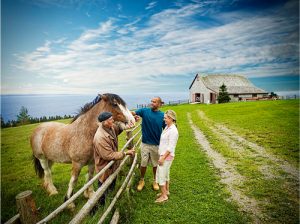
Visiting the Highland Village Museum in central Cape Breton is like stepping into the past. Overlooking the Bras d’Or Lake for the past 60 years, the journey of Nova Scotian Gaels is spelled out here in stone, soil, and cedar, giving a glimpse of local life from long ago.
“We are a living history museum that tells the Gaelic story of Nova Scotia,” shares Rodney Chaisson, director of the Highland Village Museum. “Specifically, it is the story of settlers that came from the Highlands of Scotland in the late 1700s and early 1800s, and their descendants. We take visitors through four eras in time, with costumed animators telling stories and offering insight into our people’s history and heritage.”
The Hebridean-style blackhouse is where this chronological caravan starts, transporting people all the way back to Scotland of the 1700s, replete with a thatched roof and a peat fire. A log cabin brings them up to the 1770s – when the first Scottish immigrants arrived in the province aboard the Ship Hector. Mid-18th century houses, shops, and blacksmiths highlight the era of prosperity for the Nova Scotia Gaels, and the tour comes to a close with details of daily life in the early 20th century.
Area actors help to tell this tale by wearing period dress, speaking, and singing in Gaelic, and crafting tools and essentials the way their forefathers would have.

“Our mission is to tell that story, as well as to promote Gaelic language, culture, and identity in Nova Scotia today,” explains Chaisson.
He reminds us that Nova Scotian Gaelic history didn’t end one hundred years ago, however.
“As people are travelling through time on our period sites, it only takes them to the 1920s – there has been a whole century of history since then.”
The museum’s curators have wanted to tell that story for a long time. As such, they are undertaking renovations to bring the Highland Village Museum – or at least part of it – into the 21st century.
As you can imagine, it would be difficult to keep the museum open year-round as most of the on-site buildings predate indoor plumbing and proper insulation. But even the current visitor’s centre – the facility’s modern gateway to the past – isn’t up to the task.
“Our visitors have increased regularly over the years: in the three years prior to COVID, we have enjoyed record-breaking attendance,” says the museum’s President of the Board of Trustees, M.A. MacPherson. “In 2019, we had 26,000 visitors, which is more than our hosting capacity can handle. The period buildings are fine, but not in terms of welcoming people and giving them the story. Right now, they walk through the gift store and out through the back door of the shop. There is an opportunity there to give them an appropriate introduction.”
Plans are already drawn up for a modern welcome centre which would not only update the museum’s offices and gift shop but add a whole new interpretive exhibit to the Highland Village experience.
“It allows us to give them an appropriate introduction to the site and to what they are going to see,” MacPherson notes, describing the orientation exhibit gallery that will get visitors ready before crossing into the past. “It also allows us, when they are coming back, to demonstrate what has happened to the Gaelic population between 1920 and 2020.”
“There are 100 years of the Gaelic story that are missing, and we are aiming to address that.”

With additions of multipurpose community spaces, the hope is that the welcome centre will be open for historical and community programs year-round.
The project is expected to cost $5 million. After provincial, federal, and municipal funding, the museum is left to raise just over $1 million. But with visitation numbers dropping to just 2,700 this year due to lockdown, it has been challenging to raise funding.
Challenging, but not impossible.
“We have been meeting with folks via Zoom over the last several months, created some great new relationships, and right now we are about a third of the way through our goal,” notes Chaisson, with MacPherson adding that they have been “getting very good reception, so we are optimistic that will meet our goal.”
The new welcome centre will be ready for the 2022 season. Those wishing to donate to the cause can do so via the museum’s website.
www.highlandvillage.novascotia.ca




















Leave a Comment